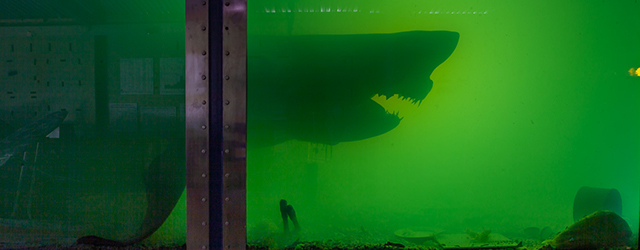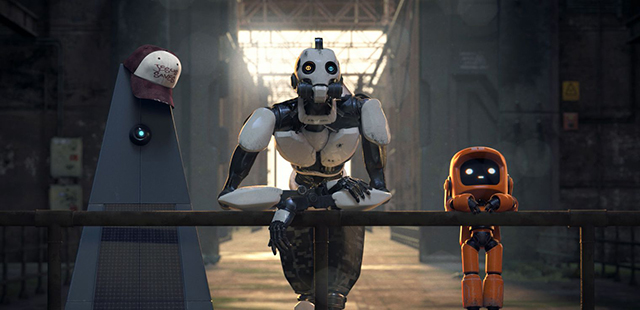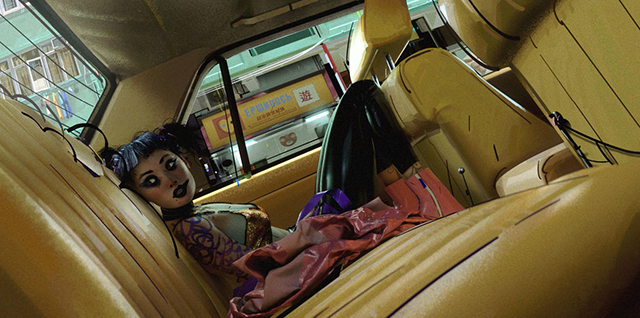
Ahoy! This is the Weekly Churn, where every Sunday I post about what I’ve been reading, watching, and thinking about over the previous week.
What are the things that haunt you? I was thinking about that on Monday when I saw this story about Rosie, the corpse of a white pointer shark abandoned in a vat of formaldehyde. The images of Rosie are quite bracing; she floats suspended in murk, silent, motionless, appearing no less lethal than she would have in life—her stillness may even amplify that effect.

Dom Krapski writes that seeing Rosie surrounded by “crap” spoils the haunting experience, but Gary Moore’s photographs leave me with a different impression. The stuff in the tank intensifies that haunted feeling for me. I can imagine the tank being cleaned out by human hands, but it is not possible for me to do so without me also imagining the shark slowly, carefully, even gently, moving to meet those hands… Even just thinking about being in close proximity to the corpse of so powerful a predator fills me with dread. There is obviously something deep and old about that emotion. Most human beings haven’t had to worry about animal predation for a very long time, but the fear of it is still there inside us. I grew up in a remote rural town and worked for years in the bush, so I’m used to wild animal encounters and understand how to be safe in those environments, but still, a hostile animal coming at me out of the trees is one of my greatest fears. It haunts me. The word “haunted” also implies ghost stories, and those aren’t just about fear; they’re wrapped up in grief, guilt, and regret. Like our instinctual fear of predatory animals, we drag these things behind us like fouling on a ship’s hull.
If you feel bad for poor Rosie, I bring good news: her body is now in a better home, and there is a fundraising effort underway to help safely restore and preserve her. And if you’ve enjoyed this thrilling shark-related content, you may also enjoy this browser-based shark game, which seems to be called something different every time I load the site. Train some Science Sharks!

I watched Love, Death + Robots on Netflix this week, and it was very uneven. “Three Robots,” a post-apocalyptic short based on work by John Scalzi, is the best piece overall. It’s a clever little thing about three robot tourists who go sightseeing through the rubble left behind after we humans destroyed ourselves through greed and stupidity. It has kind of a Pixar feel to it, like Wall-E but sharper, without the need to make it appealing to small children. It’s interesting that the best vocal performance is the one that wasn’t a vocal performance at all—the lines were apparently read by a piece of software.
“The Witness” is the best animated; it just rides the edge of the uncanny valley while using some of the techniques that made Into the Spider-Verse so stunning. Filmmaker Aaron Stewart-Ahn was critical of its use of an Asian city to signal “the future,” and that’s certainly fair. Despite the Asian writing on some of the buildings and signs (I don’t recall which language the writing is in, and I don’t plan on watching it again), the architecture, characters, and the little bits of sub-culture we see have a more post-Soviet Eastern Bloc vibe to them, in my opinion, a cultural context that North Americans had very few meaningful glimpses of for a very long time, and “The Witness” looks more like Atomic Blonde than Blade Runner. That kind of unfamiliarity often reads as futuristic. Concrete architecture, which figures heavily in the setting, also ages differently from other architecture, and that difference is often deliberately manipulated by architects; it isn’t timeless so much as difficult to place in time, and that has consequences for how we read it.

The biggest shame about “The Witness” is that the time loop story, something which is over done generally but has a lot of potential when executed well, is about little more than a terrified woman fleeing for her life.[ref]Or believing that’s what she’s doing; she is ultimately both murderer and murdered, pursued and pursuer.[/ref] I think there are other, better ways to show such visually interesting characters in vibrant, kinetic situations without making it a study of women’s fear or of violence against them. “The Witness” offers only voyeurism and objectification with nothing in the way of critique or challenge. And that, frankly, is the problem with the series as a whole. Over and over again spectacular animation is used to tell puerile or otherwise problematic stories that are labelled as “mature” because they have swearing, nudity, or sexual content in them. A couple, like “Blindspot” and “Sucker of Souls,” were so bad I honestly thought they were parodies of certain genres at first. There are some good things in Love, Death + Robots, but expect to have to wade through some crap to find them.
 Jenny Lewis released a new album this week, and it’s great. I haven’t internalized much of it yet, so don’t expect anything like a full accounting of it here, but right off the bat I’m enjoying On the Line more than 2014’s Voyager, though it won’t dethrone Rabbit Fur Coat as the best album of her career.[ref]And let’s be frank, one of the best albums of the ’00s.[/ref] It has fewer of the ennui-drenched pop hooks I’ve come to love—there’s nothing like “You Can’t Outrun ‘Em” or “Jack Killed Mom” on the new album—but it’s more solid overall. I’ve long believed that, as both a songwriter and a performer, Jenny Lewis is the best successor to Johnny Cash as chronicler of Americana via the creation of a personal mythology. Lewis’ lyrics and melodies feel intimate, but they reach out into that great open space where America’s sense of self lives and pull forgotten bits of it back in with them, little ghost Americas that had brief, intense lives and then vanished into show business apocrypha. She comes from a different place than Cash, and her America is different, but it’s no less powerful a myth. I’ve never sat by a dirty motel pool at the edge of Los Angeles, all the colour washed out by the afternoon sun, but after listening to these songs I’m pretty sure I could tell you what that feels like. Jenny Lewis is a folk musician, lounge singer, balladeer, and indie rocker all rolled into one, a mix that should produce a muddled mess but that instead gives us utter clarity. It’s hard to classify her songs except to say that they are hers, and you know them in a way that you don’t know other songs. She reminds me of Erika Wennerstrom, another chronicler of Americana, who has a more consistently solid body of work but who hasn’t managed to meld the personal and mythological as effectively. My favourite tracks after my first listen: “Heads Gonna Roll,” “Do Si Do,” and “Little White Dove.” For a really excellent take on Jenny Lewis, I suggest you read this Griefbacon newsletter entry by Helena Fitzgerald. We come at Lewis’ work from completely different angles, but I think there’s a lot of interesting overlap.
Jenny Lewis released a new album this week, and it’s great. I haven’t internalized much of it yet, so don’t expect anything like a full accounting of it here, but right off the bat I’m enjoying On the Line more than 2014’s Voyager, though it won’t dethrone Rabbit Fur Coat as the best album of her career.[ref]And let’s be frank, one of the best albums of the ’00s.[/ref] It has fewer of the ennui-drenched pop hooks I’ve come to love—there’s nothing like “You Can’t Outrun ‘Em” or “Jack Killed Mom” on the new album—but it’s more solid overall. I’ve long believed that, as both a songwriter and a performer, Jenny Lewis is the best successor to Johnny Cash as chronicler of Americana via the creation of a personal mythology. Lewis’ lyrics and melodies feel intimate, but they reach out into that great open space where America’s sense of self lives and pull forgotten bits of it back in with them, little ghost Americas that had brief, intense lives and then vanished into show business apocrypha. She comes from a different place than Cash, and her America is different, but it’s no less powerful a myth. I’ve never sat by a dirty motel pool at the edge of Los Angeles, all the colour washed out by the afternoon sun, but after listening to these songs I’m pretty sure I could tell you what that feels like. Jenny Lewis is a folk musician, lounge singer, balladeer, and indie rocker all rolled into one, a mix that should produce a muddled mess but that instead gives us utter clarity. It’s hard to classify her songs except to say that they are hers, and you know them in a way that you don’t know other songs. She reminds me of Erika Wennerstrom, another chronicler of Americana, who has a more consistently solid body of work but who hasn’t managed to meld the personal and mythological as effectively. My favourite tracks after my first listen: “Heads Gonna Roll,” “Do Si Do,” and “Little White Dove.” For a really excellent take on Jenny Lewis, I suggest you read this Griefbacon newsletter entry by Helena Fitzgerald. We come at Lewis’ work from completely different angles, but I think there’s a lot of interesting overlap.
That’s all for this week. Thanks for reading!